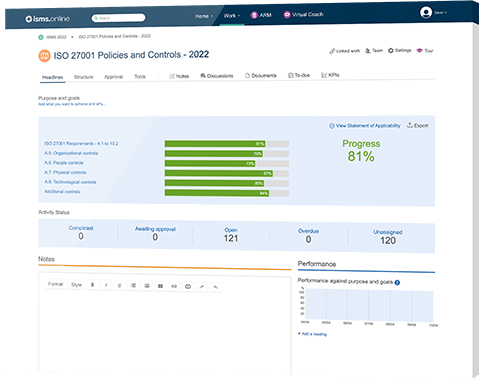
Access Control governs the ways in which human and non-human entities on any given network are granted access to data, IT resources and applications.
As per the supplementary guidance, Control 5.15 mentions (but does not limit itself to) four different types of access control, which can be broadly classified as follows:
5.15 is a preventative control that maintains risk by improving an organisation’s underlying ability to control access to data and assets.
5.15 is explicit in stating that access to resources should be granted and amended based on a concrete set of commercial and informational security requirements.
Organisations should implement 5.15 in order to facilitate secure access to data, and minimise the risk of unauthorised access to their network – be it physical or virtual.
| Control type | Information security properties | Cybersecurity concepts | Operational capabilities | Security domains |
|---|---|---|---|---|
| #Preventative | #Confidentiality #Integrity #Availability | #Protect | #Identity and access management | #Protection |
Whilst 5.15 relies upon managerial staff from various parts of an organisation maintaining a thorough understanding of who needs access to what resources (i.e. HR informing on an employees job role, which in turn dictates their RBAC parameters), access rights are ultimately a maintenance function that are controlled by staff with administrative rights over any given network.
As such, ownership of 5.15 should rest with a member senior management with overarching technical authority across an organisation’s domains, subdomains, applications, resources and assets, such as a Head of IT.
Compliance with Control 5.15 involves adhering to what’s known as a ‘topic-specific’ approach to Access Control (more commonly known as an ‘issue-specific’ approach).
Topic-specific approaches encourage organisations to create Access Control policies that are tailored towards individual business functions, rather than adhering to a blanket Access Control policy that applies to data and resource access across the board.
Control 5.15 requires Access Control policies across all topic-specific areas to take the following 11 guidance points into consideration. Some of the below guidance points intersect with various other controls, which are listed for reference.
Organisations should consult these accompanying Controls on a case-by-case basis, for further information.
Compliance – This is easily achieved by keeping an accurate record of job roles and data access requirements, that is in line with your organisational structure.
Compliance – A formal risk assessment could be carried out to examine the security characteristics of individual applications.
Compliance – Your organisation needs to be able to demonstrate that you have a robust set of building and room access controls, including managed entry systems, security perimeters and visitor procedures, where appropriate.
Compliance – Companies should adhere to strict best-practice policies that do not offer blanket access to data across an organisational chart.
Compliance – Data access privileges above and beyond that of a standard user need to be closely monitored and audited.
Compliance – Organisations tailor their own Access Control policies in accordance with any external obligations they have with regards to data, asset and resource access.
Compliance – Policies should include controls that eliminate an individual’s ability to compromise a broader Access Control function, based on their own levels of access (i.e an employee who has the ability to request, authorise and implement changes to a network).
Compliance – Access Control policies need to acknowledge that whilst Access Control is a self-contained function, it’s made up of a number of individual steps that carry their own set of requirements on a topic-by-topic basis.
Compliance – Organisations should implement an authorisation process that requires formal, documented approval from an appropriate member of staff.
Compliance – Data integrity and security perimeters need to be maintained through a continual cycle of periodic audits, HR oversight (leavers etc.) and job-specific changes (e.g. departmental moves and role amendments).
Compliance – Organisation should collect and store data on access events (e.g. file activity) alongside safeguarding against unauthorised access to security event logs, and operate with a comprehensive set of incident management procedures.
It helps drive our behaviour in a positive way that works for us
& our culture.
As we’ve discussed, Access Control rules are granted to various entities (human and non-human) that exist on a given network, which in turn are given ‘roles’ that dictate their overall requirements.
As your organisation defines and enacts its own set of Access Control policies, 5.15 asks you to take the following 4 points into consideration:
Control 5.15 is explicit in requiring organisations to preoccupy themselves with documentation and a structured list of responsibilities. ISO 27002 contains numerous similar requirements across its entire list of controls – here are the individual controls that are most relevant to 5.15:
Control 5.15 gives organisations a significant amount of leeway when it comes to choosing the level of granularity contained within their Access Control rules.
ISO advises companies to exercise their own judgement on how detailed a given set of rules need to be on an employee-by-employee basis, and how many access variables are applied to any piece of data.
5.15 explicitly acknowledges that the more detailed a company’s Access Control policies are, the greater the cost and the more difficult the whole concept of Access Control becomes across multiple locations, network types and application variables.
Access Control as a concept, unless closely managed, can soon get out of hand. It is almost always a good idea to simplify Access Control rules to make them easier and more cost-effective to manage.

We’ll give you an 81% headstart
from the moment you log in
Book your demo
27002:2013/5.15 is an amalgamation of two similar controls in 27002:2013 – 9.1.1 (Access control policy) and 9.1.2 (Access to networks and network services).
In general, both 9.1.1 and 9.1.2 address the same underlying themes as 5.15 and broadly follow the same set of governance guidelines, with some subtle operational differences.
Both the 2022 and 2013 controls deal with administering access to information, assets and resources and operating along a “need to know” principle that treats corporate data as a commodity which needs to be closely managed and protected.
All of 27002:2013/9.1.1’s 11 governing guidelines run along the same general lines as is seen in 27002:2013/5.15, with the latter featuring a marginally greater emphasis on physical security and perimeter security.
Supporting guidance on Access Control implementation is broadly the same, however the 2022 control does a much better job of offering concise, practical guidance across its 4 implementation guidelines.
5.15 acknowledges the different kinds of Access Control methods that have emerged over the last 9 years (MAC, DAC, ABAC), whereas 27002:2013/9.1.1 limits its guidance to RBAC – the most common method of commercial access control at that time.
In conjunction with technological changes that offer organisations greater control over their data, neither of the 2013 controls contain any meaningful direction on how an organisation should approach granular access controls, whereas 27002:2013/5.15 gives organisations a significant amount of leeway.
| ISO/IEC 27002:2022 Control Identifier | ISO/IEC 27002:2013 Control Identifier | Control Name |
|---|---|---|
| 5.7 | New | Threat intelligence |
| 5.23 | New | Information security for use of cloud services |
| 5.30 | New | ICT readiness for business continuity |
| 7.4 | New | Physical security monitoring |
| 8.9 | New | Configuration management |
| 8.10 | New | Information deletion |
| 8.11 | New | Data masking |
| 8.12 | New | Data leakage prevention |
| 8.16 | New | Monitoring activities |
| 8.23 | New | Web filtering |
| 8.28 | New | Secure coding |
| ISO/IEC 27002:2022 Control Identifier | ISO/IEC 27002:2013 Control Identifier | Control Name |
|---|---|---|
| 6.1 | 07.1.1 | Screening |
| 6.2 | 07.1.2 | Terms and conditions of employment |
| 6.3 | 07.2.2 | Information security awareness, education and training |
| 6.4 | 07.2.3 | Disciplinary process |
| 6.5 | 07.3.1 | Responsibilities after termination or change of employment |
| 6.6 | 13.2.4 | Confidentiality or non-disclosure agreements |
| 6.7 | 06.2.2 | Remote working |
| 6.8 | 16.1.2, 16.1.3 | Information security event reporting |
| ISO/IEC 27002:2022 Control Identifier | ISO/IEC 27002:2013 Control Identifier | Control Name |
|---|---|---|
| 7.1 | 11.1.1 | Physical security perimeters |
| 7.2 | 11.1.2, 11.1.6 | Physical entry |
| 7.3 | 11.1.3 | Securing offices, rooms and facilities |
| 7.4 | New | Physical security monitoring |
| 7.5 | 11.1.4 | Protecting against physical and environmental threats |
| 7.6 | 11.1.5 | Working in secure areas |
| 7.7 | 11.2.9 | Clear desk and clear screen |
| 7.8 | 11.2.1 | Equipment siting and protection |
| 7.9 | 11.2.6 | Security of assets off-premises |
| 7.10 | 08.3.1, 08.3.2, 08.3.3, 11.2.5 | Storage media |
| 7.11 | 11.2.2 | Supporting utilities |
| 7.12 | 11.2.3 | Cabling security |
| 7.13 | 11.2.4 | Equipment maintenance |
| 7.14 | 11.2.7 | Secure disposal or re-use of equipment |
We’re so pleased we found this solution, it made everything fit together more easily.